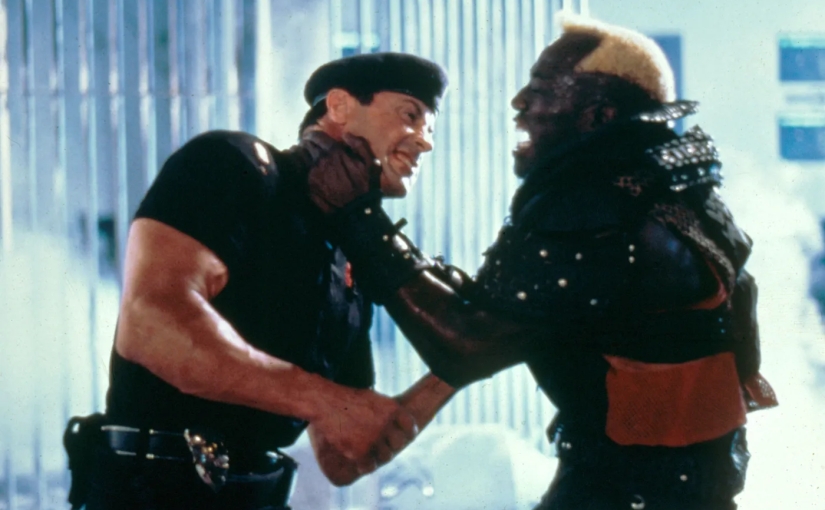By Marc S. Sanders
In the years since the Sylvester Stallone/Wesley Snipes futuristic action picture Demolition Man came out in 1993, bloggers have been giddy to post about how brilliant the satire is, especially since much of its fictional future set in a totalitarian San Angeles (formerly Los) in the year 2032 ended up becoming real to some degree. Okay, fine. I’ll go with what they say. However, Reader, this is not on the same level as Paddy Chayefsky’s prophetical film, Network, and the legacy it has bestowed. Demolition Man remains just as stupid as it was when it first came out.
In a mid-1990s prologue of fire, gunfire, and flames, a vicious killer named Simon Phoenix (Snipes), with a happy go lucky habit of giggling through the mayhem he unleashes, is apprehended by decorated cop John Spartan (Stallone). However, both men are sentenced to decades of cryo-freeze imprisonment because the hostages that Phoenix held had perished and Spartan was found neglectful.
The film jumps to 36 years later. Phoenix has been released and immediately returns to his old habits. The problem is the law enforcement of this period is not equipped to contain the crazed criminal. So, Spartan is defrosted as well to go up against Phoenix. This future is occupied by the cute smiles and charms of Sandra Bullock, Benjamin Bratt and Rob Schneider as the cops who happily sing the melodies made famous by radio and television ads. Guns are entirely outlawed along with drugs, alcohol, spicy food, and obscene language. Say a curse word and a machine is nearby, quick to charge you with the offense. Touching and the exchange of bodily fluids are forbidden as well. A high five with no contact was an uncanny precursor and is now reminiscent of the early days of the Covid crisis when it was strongly urged that people not even shake hands. About the only favorable improvement of this future is that toilet paper is no longer used, and people resort to solving their hygiene problems with three seashells. Regrettably, the technique is never demonstrated.
This film invests a lot of time in its satire, and I appreciate the attempt to find its humor. The problem is the humor is delivered by Sylvester Stallone and he’s not Bill Murray or Aaron Eckhardt (check out Thank You For Smoking). Satire is not a wheelhouse for Stallone to reside in. Sandra Bullock on the other hand is cute in her response. A memorable scene could have been so much better had Bullock had a more appropriate scene partner. Lovemaking takes on a whole new method in this 2032 future. Head devices are used to stimulate the mind. Oddly enough, you could say that’s the direction that virtual reality has taken. I appreciate the intuitiveness, but Stallone’s performance doesn’t. What was intended to be a foreign experience for sexual gratification, comes off very clunky with Stallone. Imagine what Ben Stiller or Paul Rudd could have done here. Bruce Willis would have been marvelous in a scene like this.
Wesley Snipes is just as good an action star as Stallone or Willis or Schwarzenegger. Unfortunately, his Simon Phoenix is so one note as a villain. He’s a got a bleach blonde crew cut and a giggle and nothing else. Stallone’s character describes Phoenix as a dirt bag, and the dastardly bad guy shoots guns and does quick kicks. There’s nothing to know or learn about this guy. He’s just a target for Sylvester Stallone to do his typical Sylvester Stallone with a shotgun and a handgun and his signature rahhhhhhh bellow that he’s provided in Rambo and Cliffhanger and Cobra and most of the rest of his career. (Don’t get me wrong though. Stallone does have a good repertoire of movies. This one in particular is what doesn’t work.)
Denis Leary lends to the thin plot for a time. Back in ’93, Leary was known for a few MTV ads where he did his infamous ranting monologue while popping a cigarette. Because the script for Demolition Man is so nil, the angry comedian is granted opportunity to do his schtick here…twice! It didn’t amuse me in ’93. Now it’s just terribly outdated.
Back to the satire, I question the response of the players. This film takes place only 36 years after a time of violent crime and cursing and smoking and drinking and all the debauchery that we were tolerated. When Rob Schneider and the police look shocked and terrified at Simon Phoenix’ measure of violence, they are completely oblivious to what’s occurring. I dunno. Should they be that gullible? This guy is only from a time that’s just over thirty years ago. It hasn’t been that long. Bullock even has a poster of Lethal Weapon 3 hanging in her office. The response was hard for me to swallow, and that’s what killed the satirical attempts. You can’t be that dumbfounded or naïve, can you?
There was a good idea here, but any kind of semblance of thought went out the window once that was jotted down. The right player was not inserted into the main slot. Stallone is miscast. That’s the biggest problem. Demolition Man hinges on the ho hum gunplay of any Sylvester Stallone actioner and stands on a sliver of irony with how dynamics have played out since the film’s release. That’s not enough to consider it a fun kind of popcorn flick, though. Demolition Man needs to remain frozen in time.





